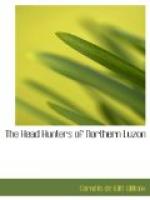Bubud was then passed about—but this is going too fast! Bubud (called tapuy elsewhere) is an institution in the parts where we now were, and I had been hearing of it for days. It is the native (Ifugao) name of a drink produced by the fermentation of rice, a drink that varies in color and in flavor, according to the care taken in its make, but nearly always agreeable to the palate and refreshing. That offered us to-day was greenish yellow, slightly acid and somewhat bitter from the herbs added. Unfortunately, it will not bear transportation, but we made up for this by carrying off personally as much as was convenient. It had a happy effect on my pony, too: all the way to Aritao he had been slower than the wrath to come, but from this on he showed life and spirit; in fact, he danced and pranced through every town we crossed for some days afterward. I always meant to ask if some one had given him any bubud at Aritao, during the speech-making; on reflection I am inclined to doubt it, but at any rate, in honor of the circumstances, he was known as Bubud the rest of the trip.
A short ride through the charming, smiling country (part of it might have been France), over a really good road most of the way, brought us to Dupax. On the way we were met by some of the American officials of the province, among them Mr. Norman Connor, Superintendent of Education (Yale, 1900), and by two Belgian priests, De Wit of Dupax and Van der Maes of Bayombong. The natives met us, all mounted, with a band, so that we made a triumphant entrance, advancing in line to the presidente’s house, while the church-bell pealed out a welcome.
Dupax must, like Aritao, have been a point of some importance in the past. It has a large brick church with a decidedly Flemish facade, and a detached pagoda-like belfry. Its streets are overgrown with fine soft grass, and its houses had somehow or other an air of comfort and ease. Here we made quite a stop, first of all quenching our thirst with bubud, beer, cocoanut milk, anything, everything, for we had ridden nearly all the way so far in the sun. We then sat down to an excellent breakfast, and smoked and lounged about until two, when fresh ponies were brought, and we set off on a side trip to Campote, where we were to have our first contact with the real wild man, the Ilongot. [12]
CHAPTER VI
The Ilongots and their country.—Efforts
of our Government
to reach these people.—The
forest trail.—Our first contact
with the wild man.




